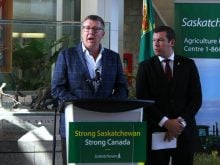It has been a tough year for the Environmental Farm Plan program, the most popular and successful agricultural program to come out of the Agricultural Policy Framework era.
It is the transition year between the APF that expired March 31 and the Growing Forward framework that replaces it.![]()
As well, bridge funding was lower than in 2007-08, which in most provinces meant a reduction in activity and a mid-year suspension of EFP financial help for farmers who want to introduce new environmentally friendly technology or practices to their operation.
Read Also

Anti-separatist movement targets rural Alberta
Former deputy premier Thomas Lukaszuk’s anti-separatism Alberta Forever Canada petition campaign expects to run full steam ahead into the province’s farming regions
There is also uncertainty about whether the next generation of EFP programming will be ready for its April 1 launch because Ottawa still is negotiating details and funding plans individually with all provinces. The six-week election campaign interrupted these negotiations.
“It certainly has been a challenging year,” said Wanda McFadyen, executive director of the Farm Stewardship Association of Manitoba, which administers the program in that province.
“The allocation of funds has been cut and that means we have been fully subscribed for several months so we can’t accept new farmers into the stewardship program. I know this has frustrated some farmers.”
She said uncertainty about the details and budgets for the new program is unsettling.
“Time is passing and a little bit of certainty would be nice.”
In Edmonton, the Alberta Environmental Farm Plan Corp. is able to organize a reduced schedule of EFP workshops only because the Alberta government provided transitional funding that normally would come from Ottawa.
Like many other provinces, Alberta has no money for the rest of the fiscal year to help farmers who have been through the workshop process and now want to invest in their farms to correct identified environmental problems.
“The province has forwarded money to us that has allowed us to continue limping along with limited activities,” said executive director Mike Slomp.
“This is a setback but I don’t think in the long run it will affect the credibility of the program, although it certainly has been a setback for our ability to meet demand.”
Richard Escott, senior program officer at the Prairie Farm Rehabilitation Administration, which administers the stewardship part of the program, said the cut in funds during the transition year needs perspective.
In 2007-08, many farmers who had attended workshops and prepared their own peer-reviewed proposals for on-farm changes applied for money to help make those changes before the APF expired.
Spending on the National Farm Stewardship Program that partially compensates farmers for environmental investments jumped to $109 million from $46 million the previous year.
This fiscal year, the stewardship budget is $44 million.
“There was a huge jump in demand last year because people wanted to complete their work before the program year ended,” Escott said.
“That level of spending is unsustainable and I would expect when the new agreements are signed, funding levels over the length of the program will resemble funding under the EFP. But this year, with demand high, the Prairies and some other provinces ran out of money a couple of months ago.”
The EFP program has been a tremendous success, starting in 2003 and attracting 81,000 farmers to workshops by mid-2008. EFP workshops are where environmental farm issues are discussed and producers encouraged to identify problems on their farms and propose solutions.
More than 44,000 farmers have invested in improvements, acting on the workshop results, which include reducing runoff, strengthening chemical storage safety and buying a GPS that makes fertilizer and chemical application more efficient and less wasteful. The program refunds 30 to 50 percent of costs.
Rob Brunet, vice-president of Keystone Agricultural Producers, is not surprised at the strong farmer response.
After going through the program, he double walled his fuel storage container, added zero till to his operation and bought a GPS.
“It has made a difference on my farm, but I think what the program really does is encourage farmers to look at their operation in a different way,” he said.
“The bottom line is important, but decisions also have to take into account our environmental impact.”
McFadyen said farmers who have taken the program in Manitoba often say it has made them aware of chemical storage dangers and the need to take used tires to town and ensure their water supply is not at risk of contamination.
“They realize their farm yards are where they live and they want the environment for their family to be as healthy as possible,” she said.














